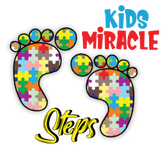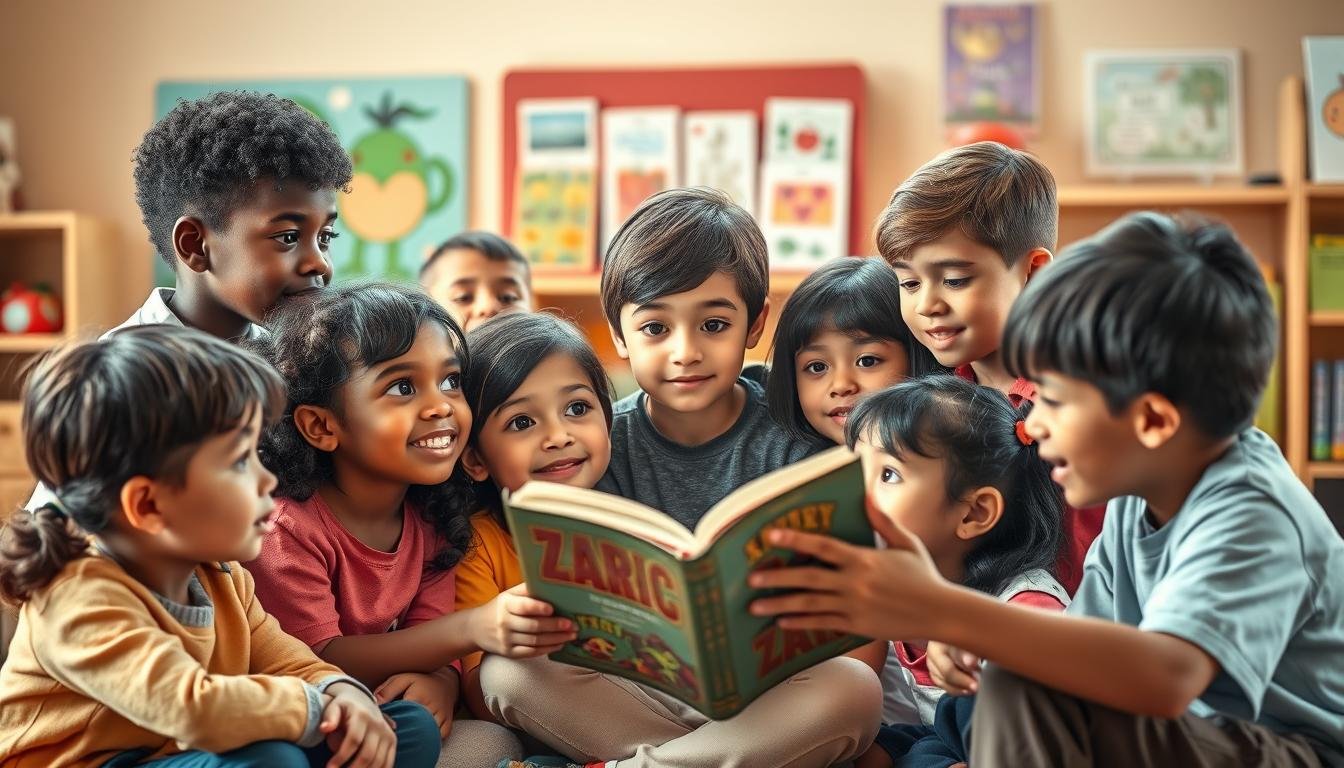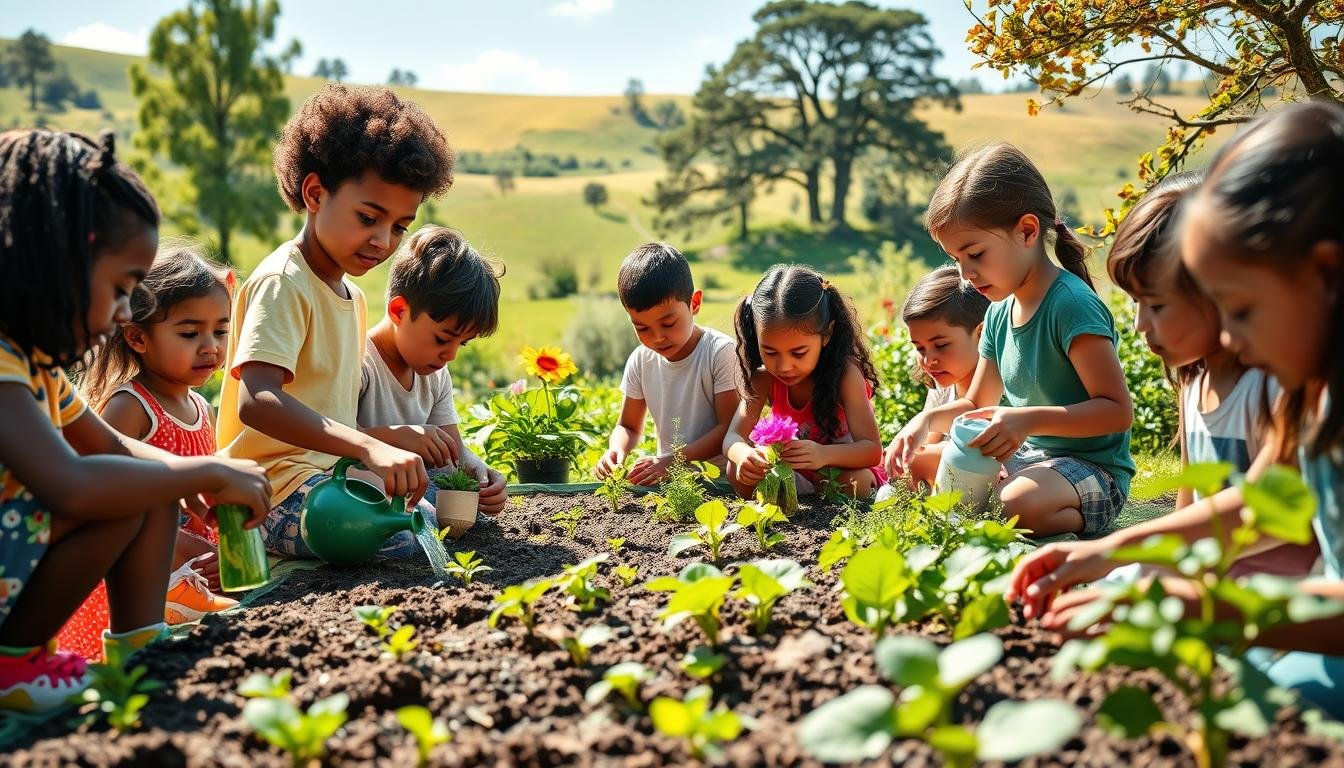We stand at the brink of an education revolution. Here, empathy and understanding build the core of inclusive learning. But how can we make this real for kids with special needs? The secret starts with a story. Interactive storytelling for kids with special needs is more than a teaching method; it opens a world where all kids are listened to, understood, and cherished.
Picture a classroom where every kid, no matter their abilities, becomes part of the stories shared. This is what interactive storytelling offers—a way to make learning alive for educational support. For kids with special needs, these aren’t just stories. They’re bridges to belonging and community.
As guardians of our future, we see interactive storytelling as more than a strategy. It’s a heartfelt tool that fosters a nurturing environment where diverse growth is celebrated. Let’s dive into how we can make our educational spaces places of joy, imagination, and inclusion at every story’s twist and turn.
The Importance of Inclusion in Early Childhood Education
Inclusion is about ensuring every student feels valued and supported. It’s not just a policy but a commitment to making learning accessible to all. It means recognizing every student’s unique abilities. By doing this, we help all students grow in a respectful and supportive culture.
Inclusion affects early childhood education greatly. It helps children with special needs get involved in their lessons and with others. Starting with inclusion early sets a good base for learning that meets various needs and styles.
Inclusion doesn’t only help kids with special needs. All students gain from learning paths that fit them. This approach makes a classroom where differences are celebrated. Everyone feels seen and valued. This also teaches important values like diversity and inclusion from a young age.
Yet, to make this a reality, we have to do more than just want it. We need strategies for better access and materials for various learning styles. By being thoughtful about our resources, we can ensure no child is left behind. This is how we achieve real fairness in education.
Bringing inclusion into early childhood education changes everything. It helps all kids do well, giving them confidence for the future. This is how education can truly change lives.
The Power of Storytelling in Learning and Development
Storytelling isn’t just a form of art; it’s a vital strategy that boosts cognitive development and communication skills. For kids, especially those with special needs, stories open doors to vast worlds. These worlds make learning not only intuitive but deeply meaningful. The story format creates a fun learning space that helps kids understand complex ideas easier.
Storytelling lets teachers introduce new words, ideas, and life lessons, enhancing language and communication. Through stories, kids practice listening, see different views, and share their thoughts better. This active engagement is key in improving their communication skills.
To make storytelling even more powerful, today’s teaching techniques include multisensory tools. By adding visual, auditory, and tactile elements, stories become more engaging for everyone. This is especially helpful for those with sensory processing issues.
But storytelling is more than just fun. It plays a big part in cognitive development. It fires up the brain in areas like memory, imagination, and problem-solving. Kids learn to spot patterns, arrange events, and understand deeper meanings. All these skills are crucial for doing well in school and in life.
When we make storytelling a key part of schooling, we turn classrooms into dynamic, welcoming places. Here, every student gets the chance to excel. This method does more than meet educational objectives; it inspires a love for learning that lasts a lifetime.
Interactive Storytelling for Kids with Special Needs: An Overview
Interactive storytelling changes how we teach kids with special needs. It mixes multimedia learning and accessible technologies. This way, it helps all children learn in a fun and active way.
These stories blend text, sound, and pictures to create a world kids can dive into. Thanks to tech advances, it’s easy to add these elements. Kids can click or talk to the story, making them feel in charge of their learning.
Interactive storytelling meets the different needs of kids. It uses easy tech so all kids can enjoy and learn from the stories. This means even kids who find usual learning hard get to succeed.
To learn more about these methods, check out this deep study. It offers important ideas for using interactive elements in teaching special needs kids.
At its heart, interactive storytelling makes education include everyone. It’s fun, works well, and treats each child’s learning needs with great care. With these practices, we’re making sure education welcomes all kids. This builds a future where every child learns with joy and ease.
Integrating Sensory Play in Interactive Storytelling
Sensory play plays a key role in improving interactive stories. It makes them inclusive. By adding sensory experiences, our stories become more engaging. This way, all kids, including those with special needs, find joy and connection.
Sensory play uses items and activities that stir the senses. These can be anything like touch-friendly textures, scented markers, or sound-making objects. They add depth to stories. Bringing these elements into storytelling lets kids learn about the world. They also develop their motor skills and thinking abilities.
- Interactive textures (touch) – Different materials can build scenes or characters, making stories feel real to the touch.
- Sound cues (hearing) – Different sounds can show changes or highlight parts of the story, adding to the audio experience.
- Visual contrasts (sight) – Using bright colors and contrasts grabs attention, important for seeing details.
- Scented elements (smell) – Scents boost the sensory experience, tying feelings or memories to parts of the story.
- Taste association (taste) – When possible, connecting flavors with the story makes it unforgettable.
By using these sensory elements, inclusive storytelling becomes a great tool for learning and fun. Sensory play in stories opens the door for all children to connect, despite their learning differences. It’s a way for everyone to find happiness and learn through play.
Creating Accessible and Engaging Stories for All Learners
In education, using universal design principles is crucial. It helps us reach all types of learners. By making stories accessible, we make sure every student, no matter their abilities or learning styles, can enjoy engaging stories. Features like touch screens, switch access, and eye-gaze technology bring stories to life for everyone.
Interactive storytelling is more than just telling stories. It creates a learning space that values each student’s unique journey. With diverse learning styles in mind, stories become impactful, personalized learning experiences. Imagine exploring a magic forest by touching a screen or solving puzzles with switch access. Every student gets to learn in a way that suits them, boosting their confidence and social skills.
We see how accessibility in storytelling changes learning for the better. Stories made for all can transform education. This approach doesn’t just meet the ideals of inclusive education. It also paves the way for the future of how we teach.
- Touch screens make stories accessible to see and touch
- Switch access helps kids with physical challenges learn at their speed
- Eye-gaze technology allows children who use their eyes to interact to explore new worlds
With careful design and new technology, we make learning stories available to everyone. Let’s keep innovating with stories that reach every learner. Together, we can create a truly inclusive learning environment.
Educational Benefits of Interactive Storytelling
Interactive storytelling greatly benefits learners, especially those with special needs. It offers educational benefits that make learning more inclusive. Through these stories, kids can grasp complex ideas in simpler ways. They act as a bridge to a broader inclusive education.
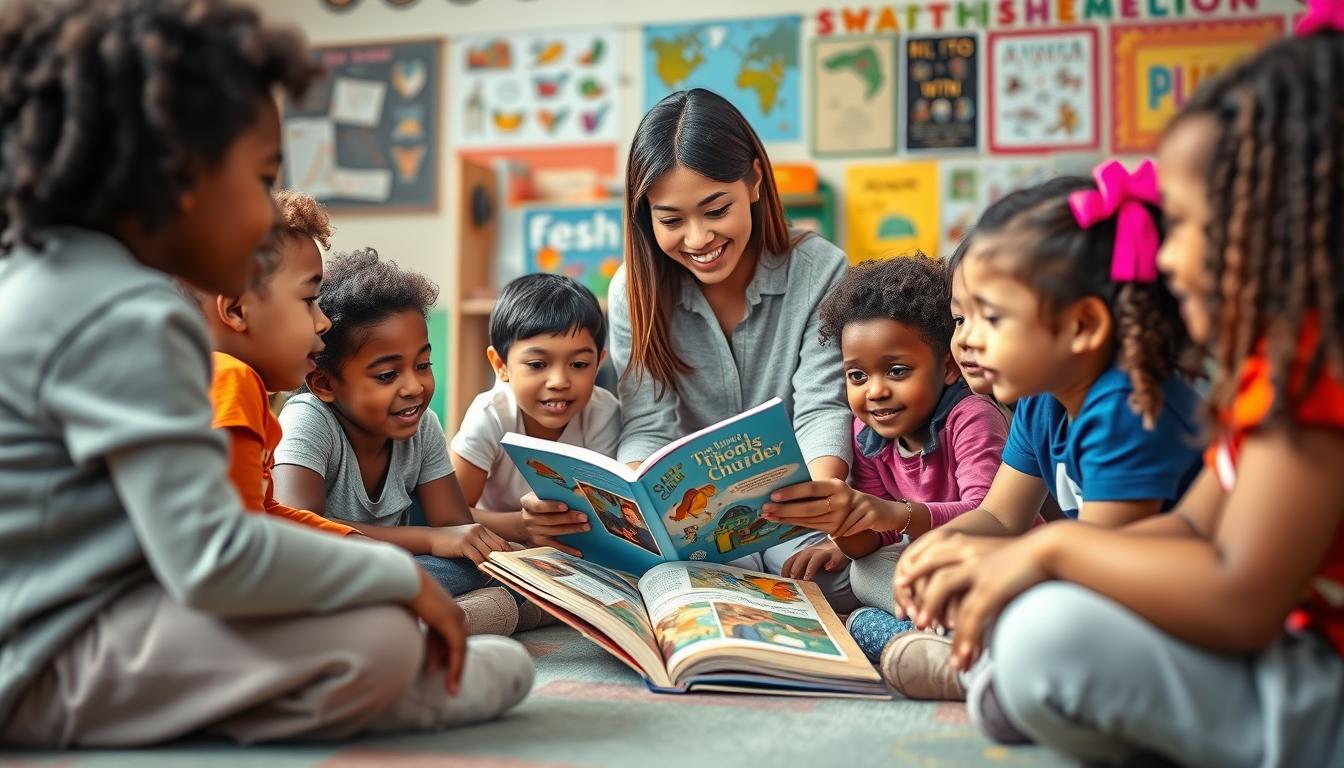
This storytelling method introduces multisensory learning. It blends visual, auditory, and tactile elements, making learning fun and easy. Every child finds a place in these stories, boosting their confidence and eagerness to learn. This leads to enhanced engagement, as students feel deeply connected to their educational journey.
| Aspect | Benefit |
|---|---|
| Cognitive Development | Improves problem-solving and literacy skills. |
| Social Skills | Promotes empathy and better interaction with peers. |
| Emotional Growth | Reduces anxiety and enhances self-expression. |
| Physical Coordination | Encourages fine motor skills through interactive elements. |
By using interactive storytelling, we make education more inclusive. These stories support academic, social, and emotional growth in children. It’s about building a learning environment that values every child’s unique perspective.
Case Studies: Success Stories in Inclusive Education
In education, many stories show the success of including everyone. These stories point out how special needs students have achieved a lot. This happens through teaching methods that involve everyone and consider all students’ needs.
A great example is a school that used storytelling in lessons. This method helped all students, no matter their learning level, and built a place where everyone’s learning style is valued. Because of this, students with special needs got better at socializing, understanding others, and their schoolwork.
- Increased engagement in classroom activities
- Enhanced understanding and empathy among peers
- Notable academic improvements and personal achievements
These stories show how important it is to use inclusive methods and tools in schools. They set an example for other schools that want to make their teaching more inclusive. They prove that with the right tools and methods, students with special needs can do well.
Every time teachers focus on including everyone and use the right tools, students with special needs do better. These success stories are not just uplifting. They also offer real ways for teachers everywhere to make their classrooms a place where every student can succeed.
Innovative Tools and Resources for Interactive Storytelling
Exploring the world of interactive storytelling, it’s important to talk about how new tools and learning resources change regular stories into fun, educational experiences. These tools help storytellers and improve learning for kids with special needs.
Using adaptive art tools is a key part of making engaging interactive stories. These tools are made so every child, no matter their abilities, can share their ideas creatively. They are vital for creating education that includes everyone.
| Tool | Description | Age Group |
|---|---|---|
| Fat Brain Toys Dado Squares | Enhances creativity and visual-spatial reasoning | 3 years and above |
| Playskool Mr. Potato Head | Improves fine motor and receptive language skills | 2 years and up |
| JaxoJoy 122-Piece Deluxe Pretend Play Food Set | Helps identify different kinds of food, boosting verbal communication | Varies |
Digital tools and online materials are also key to growing interactive storytelling. They offer detailed plans, printables, and lists of props for a story. Such tools are essential, helping teachers conduct storytelling sessions that are fun and educational.
By always using these tools and resources for storytelling, we help children with special needs learn better. We also make our community more caring and understanding.
Strategies for Implementing Interactive Storytelling in Your Classroom
Interactive storytelling may seem hard to add to lessons, but it’s doable and rewarding with the right approach. We’ll look at several strategies that fit your teaching style and help every student. This way, storytelling enriches your classroom and reaches everyone.
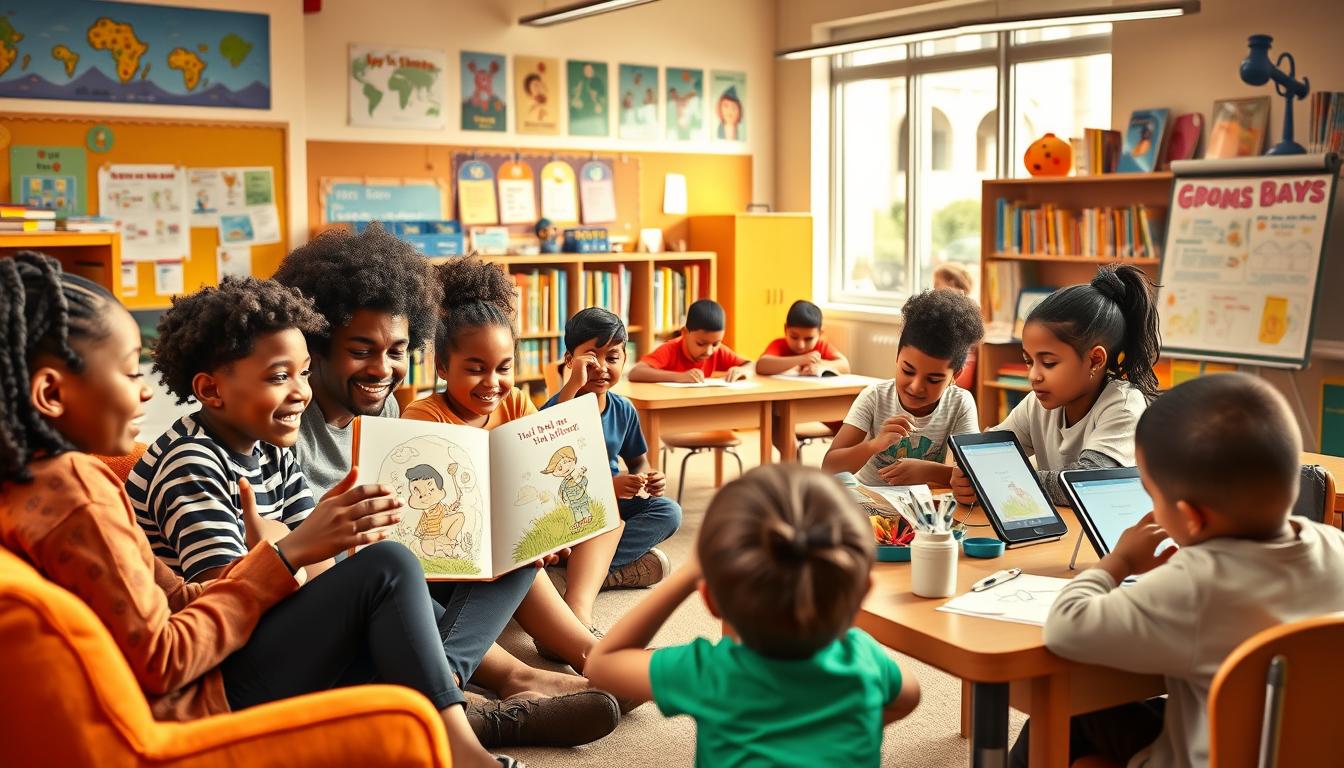
Teaching storytelling means thinking about each student’s needs. Use content that speaks to them to make learning fun and easy. And don’t forget tech! It makes stories more interactive and available to all.
| Strategy | Description | Benefits |
|---|---|---|
| Digital Storytelling Tools | Utilize apps and software that allow students to create their own narratives or participate in story creation. | Enhances creativity, improves digital literacy, and allows for personalized storytelling experiences. |
| Role-Playing | Students take on characters’ roles from stories being told, aiding in interpersonal understanding and empathy. | Encourages empathy, improves communication skills, and solidifies understanding of the narrative. |
| Interactive Story Boards | Implement physical or digital storyboards for students to add elements as they contribute to the storytelling process. | Supports visual learning, encourages contribution from all students, and fosters collaborative teamwork. |
Using these strategies makes your classroom more fun, welcoming, and educational. It lets every student have a voice and shine through storytelling. This builds a community of respect and sharing. Remember, we want to turn learning into an active and happy experience. Let’s make every student excited about learning!
Conclusion
In wrapping up, it’s obvious that interactive storytelling does more than teach. It opens a door to a world of inclusivity, understanding, and vast potential for kids with special needs. This method stands out for helping every learner, especially those with unique learning styles. It fosters empathy, engagement, and excitement in learning for all students.
From sensory integration to crafting accessible stories, we’ve looked at how special needs educational support can truly change things. We invite educators and caregivers to explore Kids Miracle Steps. These services enhance traditional education and widen opportunities for kids with special needs. By changing the stories we tell and how we tell them, you can join in this educational shift.
This is our call to action. Use what we’ve shared in your own settings. Interactive storytelling can brighten the lives of children with special needs, bringing fun and curiosity into their learning. Let’s work together for inclusivity. Let every story contribute to a larger tale of personal growth and education.
